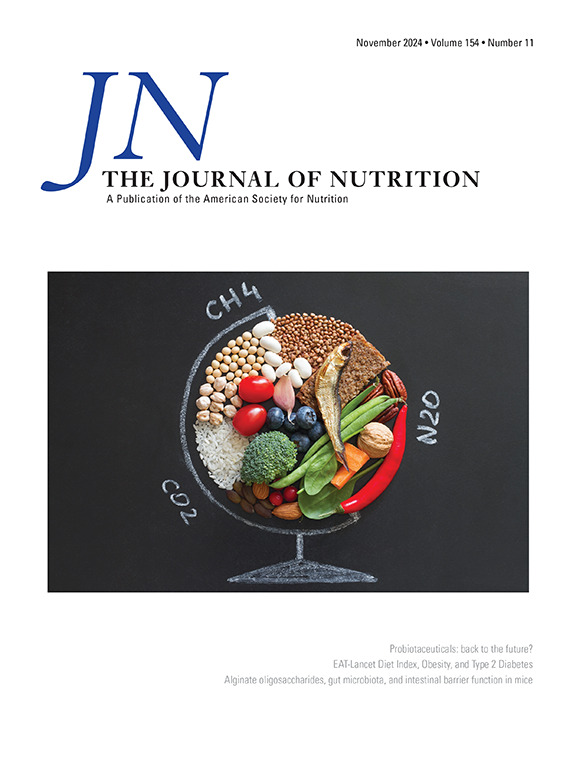血清25-羟基维生素D和完整甲状旁腺激素作为早期儿童骨量的功能生物标志物。
IF 3.7
3区 医学
Q2 NUTRITION & DIETETICS
引用次数: 0
摘要
背景:25-羟基维生素D浓度(25(OH)D)在甲状旁腺激素(PTH)浓度达到峰值时被认为是维生素D缺乏症的基准。然而,在幼儿中,关于25(OH)D-PTH关系的抑制点或其与骨量累积的相关性的证据有限。目的:探讨25(OH)D(或PTH)与骨矿物质含量(BMC)和面骨矿物质密度(aBMD)的相关性是否能证实25(OH)D对幼儿PTH抑制的阈值。方法:在对孟加拉国4岁儿童骨骼和肌肉健康(BONUSKids)研究数据的横断面二次分析中,分别采用液相色谱-串联质谱法和化学发光免疫分析法分析血清25(OH)D和完整PTH (iPTH)。采用双能x线吸收仪测定BMC和aBMD。25(OH)D、iPTH与骨骼预后(BMC、BMC z-score、aBMD和aBMD z-score)之间的关系采用多变量调整线性回归和样条模型进行建模。采用AIC比较模型拟合。结果:在534名参与者中(51%为女性),28%的25(OH)D浓度为6.7pmol/L。25(OH)D与iPTH呈反比关系的模型拟合优化,在25nmol/L处出现拐点(均为0.05)。男性和女性的关联相似。结论:在孟加拉国达卡的4岁儿童中,我们没有根据骨量与25(OH)D的关系确定维生素D缺乏症的阈值。然而,将25(OH)D提高到≥25nmol/L可能是有必要的,因为25(OH)D与低于该阈值的iPTH呈相对强的负相关。临床试验注册:Clinicaltrials.gov #NCT03537443。本文章由计算机程序翻译,如有差异,请以英文原文为准。
Serum 25-Hydroxyvitamin D and Intact Parathyroid Hormone as Functional Biomarkers of Bone Mass in Early Childhood
Background
The 25-hydroxyvitamin D (25(OH)D) concentration at which parathyroid hormone (PTH) concentration plateaus has been considered to benchmark vitamin D deficiency. However, in young children, there is limited evidence for a suppression point in the 25(OH)D–PTH relationship or its relevance to bone mass accrual.
Objectives
To determine whether the threshold of 25(OH)D at PTH suppression in young children is corroborated by associations of 25(OH)D (or PTH) with bone mineral content (BMC) and areal bone mineral density (aBMD).
Methods
In a cross-sectional secondary analysis of data from the BONe and mUScle health in Kids (BONUSKids) study of 4-y-old children in Bangladesh, serum 25(OH)D and intact PTH (iPTH) were analyzed by liquid chromatography–tandem mass spectrometry and a chemiluminescent immunoassay, respectively. BMC and aBMD were measured by dual-energy X-ray absorptiometry. Associations between 25(OH)D, iPTH, and bone outcomes (BMC, BMC z-score, aBMD, and aBMD z-score) were modeled using multivariable-adjusted linear regression and spline models. Model fit was compared using Akaike’s Information Criteria.
Results
Of 534 participants (51% female), 28% had 25(OH)D concentrations <25 nmol/L and 34% had iPTH >6.7 pmol/L. Model fit of the inverse relationship between 25(OH)D and iPTH was optimized with an inflection point at 25 nmol/L [<25 nmol/L: −0.16 pmol/L per 1 nmol/L increase in 25(OH)D; 95% confidence interval (CI): −0.22, −0.10; P < 0.001), above which the slope attenuated (≥25 nmol/L: –0.02 pmol/L; 95% CI: −0.04, −0.003; P = 0.019]. However, the positive linear associations between 25(OH)D and bone mass outcomes were monotonic (P < 0.05), and iPTH was not associated with any bone outcome in adjusted models (P > 0.05 for all). Associations were similar in males and females.
Conclusions
Among 4-y-old children in Dhaka, Bangladesh, we did not identify a 25(OH)D threshold to define vitamin D deficiency based on its association with bone mass. However, efforts to raise 25(OH)D to ≥25 nmol/L may be warranted based on the relatively strong inverse association of 25(OH)D with iPTH below this threshold.
This trial was registered at clinicaltrials.gov as #NCT03537443.
求助全文
通过发布文献求助,成功后即可免费获取论文全文。
去求助
来源期刊

Journal of Nutrition
医学-营养学
CiteScore
7.60
自引率
4.80%
发文量
260
审稿时长
39 days
期刊介绍:
The Journal of Nutrition (JN/J Nutr) publishes peer-reviewed original research papers covering all aspects of experimental nutrition in humans and other animal species; special articles such as reviews and biographies of prominent nutrition scientists; and issues, opinions, and commentaries on controversial issues in nutrition. Supplements are frequently published to provide extended discussion of topics of special interest.
 求助内容:
求助内容: 应助结果提醒方式:
应助结果提醒方式:


